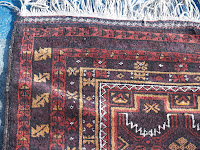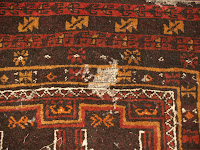
A SILK ISFAHAN RUG
Central Persia, Circa 1600
Approximately 7 ft. 7 in. x 5 ft. 7 in. (231 cm. x 170 cm.)
Pre-Lot Text
PROPERTY FROM THE DORIS DUKE COLLECTION AND THE NEWPORT RESTORATION FOUNDATION (LOTS 31-41)
From Kouchakji Frères, New York
Mrs. Rainey Rogers, Parke-Bernet Galleries, New York, 18-20 November 1943, lot 407
Hagop Kevorkian
Anonymous, Sothebys New York, 8 December 1990, lot 54
Literature
The Art News, New York, June 14, 1930, title page
Diamond, M. S., Loan Exhibition of Persian Rugs of the so-called Polish Type, New York, 1930, no. 15, plate 1
McCleary, William H., Polish Rugs from Persia, The Antiquarian, XV, 1930, p. 62
Pope, A. U., A Survey of Persian Art, London and New York, 1939, vol. III, pp. 2397-9 and illustrated in color, vol. VI, pl. 1261
Spuhler, Friedrich, Seidene Reprasentationsteppiche der mittleren bis spaten Safwiden Seit-Die soq. Polenteppiche,
Berlin, 1968, no. 141
Lot Notes
Warp: silk, ivory, Z2S, alternate warp strongly depressed
Weft: silk, ivory, 1 strand of unspun silk, 3 shoots
Pile: silk, asymmetrical knot open to the left
Density: 24-26 horizontal, 33-37 vertical per sq. in.
Sides: silk, 1 cord of 2 warps each, overcast in wine Ends: Incomplete
Colors: citrine, cashew, taupe, indigo, sand, cornflower, teal, mushroom, pale to deep raspberry, celery, cranberry, tumeric, pale aqua, balsam green, peacock blue, acorn, black (17)
This luminescent Isfahan rug is a magnificent example of the apex of Safavid art during the reign of Shah Abbas (1587 - 1629). It is remarkable not only for its luminescent beauty, but also for its intricate design and construction. Noted scholars Arthur Upham Pope and Phyllis Ackerman included the rug, then in the collection of Grace Rainey Rogers, in their seminal work, A Survey of Persian Art written in 1930. Pope wrote eloquently and poetically in detail about this rug commenting "Nothing further in the way of refinement, imagination, perfection of technique, or infinite charm of colour was produced in this period" (Pope and Ackerman, p. 2397).
The use of silk for both the warps and the wefts allows for an intricate and graceful double system of scrolling arabesque vinery and tendrils. The central medallion is very subtle allowing the rug at first glance to read as an overall infinite trellis design. If the center medallion were in its original condition it would probably have the effect of a blossom or lily pad floating on a pool. The variety of blossoms, leaves and vines make for dynamism unparalleled in carpets of this period. In addition to blossoms, Pope notes "half invisible cloudbands flutter in and out with random grace" (p. 2398). The border is equally as elegant. The spiral arabesques terminating in split-leaf tendrils are overlapped by refined and unusual "pin-wheel" rosettes. Corner resolution, often difficult with a complicated design, is handled with finesse creating a robust flow to the border.
The range of colors used here is far more expansive and harmonious than is usually seen in carpets of this period. Many of the colors belong to the yellow spectrum producing an overall subtlety that is countered by the boldness of the darker shades of emerald green, dark brown and scarlet red as well as the high notes of white and light blue. As Pope concludes: "the mellow golden glow that emanatesis no accident but the result of exceptionally careful planning, a remarkable blending of tonal effect, the whole guided by perfect taste." (p. 2398).
When sold in 1990, this rug was catalogued as Kashan, but current opinion considers it to have been woven in Isfahan, established as the capital in . Although our example is reminiscent of the small silk Kashan group from the 16th century in terms of draftsmanship, the overall tonality and design are more reminiscent of the "Polonaise" group of carpets which are securely attributed to Isfahan.
However, the present rug is far finer and more exquisitely drawn than almost all "Polonaise" examples suggesting an earlier date for this Isfahan rug. Michael Franses asserts in his article Earthsong (www.hali.com, 14 December 2007) that this rug, along with the Liechtenstein and the Czartoryski Isfahans (Pope and Ackerman, pls. 1242 and 1243), form a group that is the prototype of cotton-warped 'Polonaise' rugs. All three have a two-plane system of arabesque and tendril vinery; however, our rug is a departure from the other two in relation to construction. Whereas the Czartoryski and Liechtenstein examples are silk pile on a metal-thread ground, the Isfahan offered here is made completely of fine silk. Because of this salient difference, ours seems more delicate and refined in drawing and execution. It can be further suggested that this small group acts as the link between the earlier 16th century silk Kashan and the typical Isfahan 'Polonaise' rugs. For an example of a small silk Kashan now in the Al-Thani Collection in Doha, please see The Collection of The Barons Nathaniel and Albert von Rothschild, Christie's London, 8 July 1999, lot 190.
It is not difficult to imagine that because of the finesse of weave, delicacy of design, subtlety of color and overall harmonious balance this rug was originally intended for a dignitary or as a diplomatic gift. The rug continued to maintain an esteemed provenance residing in the collection of Grace Rainey Rogers, Hagop Kevorkian and most recently, Doris Duke and The Newport Restoration Foundation.
There is no question that this is a masterpiece of Safavid art. The rarity together with the exquisite drawing and variation of a single tonality make this one of the most elegant and compelling rugs of the Shah Abbas period.




































